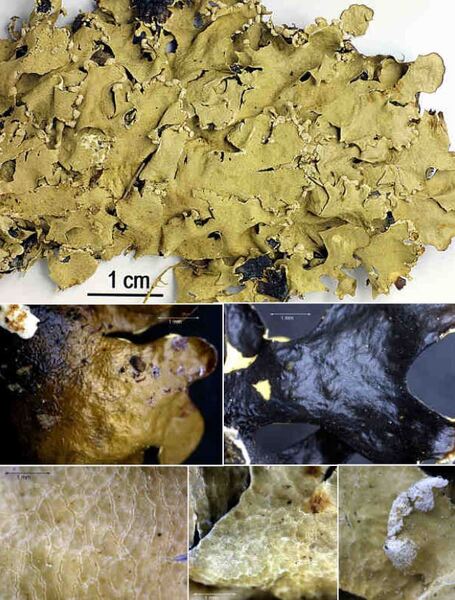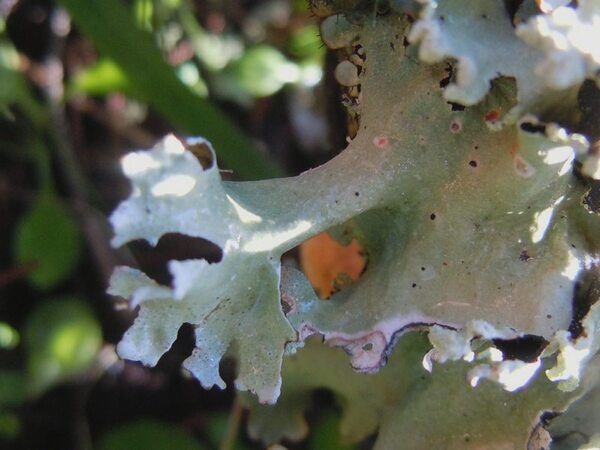Parmotrema pseudoreticulatum (Tav.) Hale
Phytologia, 28, 4: 338, 1974. Basionym: Parmelia pseudoreticulata Tav. - Portugaliae Acta Biol., Sér. B, 1: 138, 1945
Synonyms:
Distribution:
Description: Thallus foliose, heteromerous, dorsiventral, broad-lobed, loosely attached, 4-10(-20) cm in diam, sorediate. Lobes elongate, slightly overlapping, 4-12 mm wide, crenate at margins, rounded and sometimes subascending at apices, the margins with black, simple, up to 0.5 mm long cilia or often eciliate. Upper surface pale grey to grey-green, smooth, dull, weakly reticulately maculate (especially in marginal parts), with mostly laminal, more rarely marginal soralia which never arise on tiny erect lobules. Lower surface black, with a brown, up to 5 mm wide, erhizinate marginal zone, centrally with mostly simple, up to 1 mm long, black rhizines. Upper cortex of tightly packed, anticlinally oriented hyphae, with a pored epicortex, the cell walls with lichenan intermediate between the Cetraria- and the Xanthoparmelia-types; medulla white; algal layer continuous; lower cortex prosoplectenchymatous, with rounded and thick-walled cells. Pycnidia submarginal, conspicuous, the ostiole black. Conidia filiform, 8-14 x c. 1 μm. Photobiont chlorococcoid. Spot tests: upper cortex K+ yellow, C-, KC-, P+ yellow; medulla K+ yellow turning orange-red, C-, KC+ red, P+ orange-red, UV-. Chemistry: upper cortex with atranorin and chloroatranorin; medulla with salazinic acid (major) and consalazinic acid (minor), protocetraric acid (trace). Note: for a long time considered as a synonym of P. reticulatum, this cryptic species is genetically different, while the morphological differences are few and slight, often not sufficient for a correct identification (Del Prado & al. 2016). It grows on more or less coastal shrubs not far from the coast, and is known from Morocco, Portugal, Spain (including the Balearic Islands) and the British Isles; its presence in Mediterranean Italy is likely.
Growth form: Foliose, broad lobed
Substrata: bark
Photobiont: green algae other than Trentepohlia
Reproductive strategy: mainly asexual, by soredia, or soredia-like structures (e.g. blastidia)
Most common in areas with a humid-warm climate (e.g. most of Tyrrenian Italy)

Predictive model
Herbarium samples
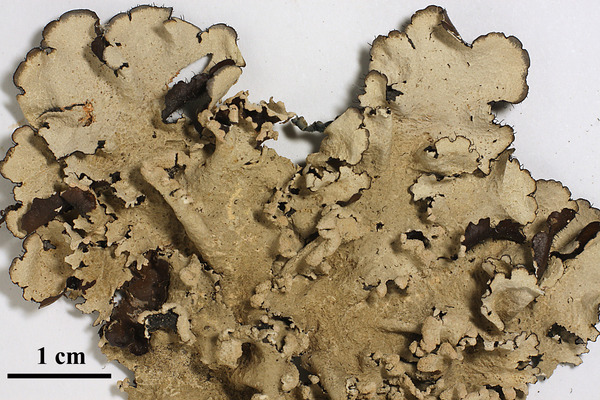

Felix Schumm - CC BY-SA 4.0
[10196], Spanien, Kanarischen Inseln, La Gomera, westlich von San Sebastian nicht weit vor der Abzweigung nach Playa Santiago, 28°05.744' N, 17°10.290' W, 840 m. Basaltblöcke in einem reich mit Kleinia bewachsenen SO-Abhanges, licht-, wind-, nebeloffen. Leg. Schumm 17.04.2003, det. Schumm 06.2004.


Felix Schumm - CC BY-SA 4.0
[10196], Spanien, Kanarischen Inseln, La Gomera, westlich von San Sebastian nicht weit vor der Abzweigung nach Playa Santiago, 28°05.744' N, 17°10.290' W, 840 m. Basaltblöcke in einem reich mit Kleinia bewachsenen SO-Abhanges, licht-, wind-, nebeloffen. Leg. Schumm 17.04.2003, det. Schumm 06.2004.
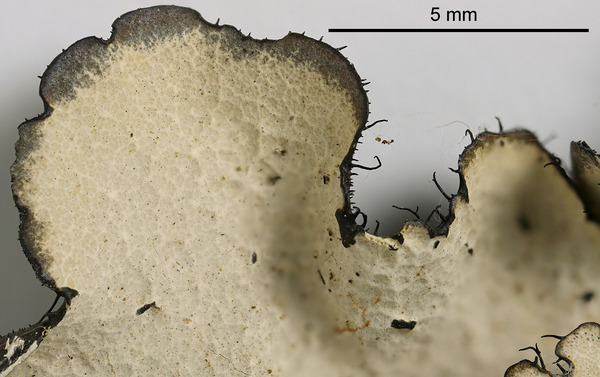

Felix Schumm - CC BY-SA 4.0
[10196], Spanien, Kanarischen Inseln, La Gomera, westlich von San Sebastian nicht weit vor der Abzweigung nach Playa Santiago, 28°05.744' N, 17°10.290' W, 840 m. Basaltblöcke in einem reich mit Kleinia bewachsenen SO-Abhanges, licht-, wind-, nebeloffen. Leg. Schumm 17.04.2003, det. Schumm 06.2004.
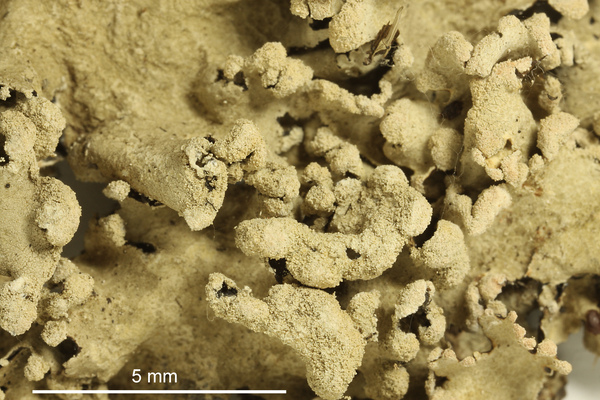

Felix Schumm - CC BY-SA 4.0
[10196], Spanien, Kanarischen Inseln, La Gomera, westlich von San Sebastian nicht weit vor der Abzweigung nach Playa Santiago, 28°05.744' N, 17°10.290' W, 840 m. Basaltblöcke in einem reich mit Kleinia bewachsenen SO-Abhanges, licht-, wind-, nebeloffen. Leg. Schumm 17.04.2003, det. Schumm 06.2004.
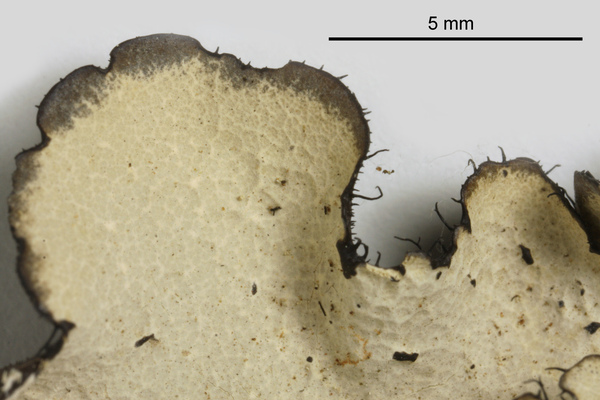

Felix Schumm - CC BY-SA 4.0
[10196], Spanien, Kanarischen Inseln, La Gomera, westlich von San Sebastian nicht weit vor der Abzweigung nach Playa Santiago, 28°05.744' N, 17°10.290' W, 840 m. Basaltblöcke in einem reich mit Kleinia bewachsenen SO-Abhanges, licht-, wind-, nebeloffen. Leg. Schumm 17.04.2003, det. Schumm 06.2004.
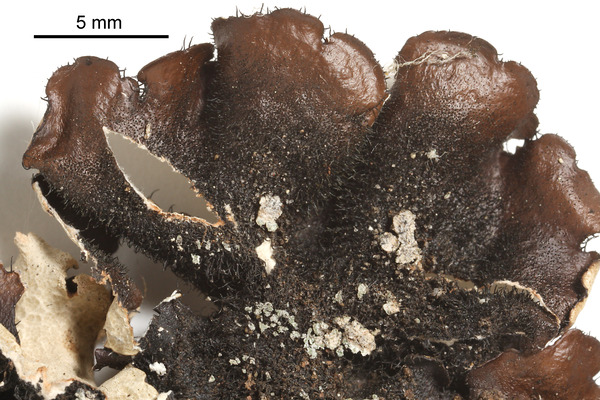

Felix Schumm - CC BY-SA 4.0
[10196], Spanien, Kanarischen Inseln, La Gomera, westlich von San Sebastian nicht weit vor der Abzweigung nach Playa Santiago, 28°05.744' N, 17°10.290' W, 840 m. Basaltblöcke in einem reich mit Kleinia bewachsenen SO-Abhanges, licht-, wind-, nebeloffen. Leg. Schumm 17.04.2003, det. Schumm 06.2004.
Growth form: Foliose, broad lobed
Substrata: bark
Photobiont: green algae other than Trentepohlia
Reproductive strategy: mainly asexual, by soredia, or soredia-like structures (e.g. blastidia)
Most common in areas with a humid-warm climate (e.g. most of Tyrrenian Italy)

Predictive model
| Herbarium samples |


Felix Schumm - CC BY-SA 4.0
[10196], Spanien, Kanarischen Inseln, La Gomera, westlich von San Sebastian nicht weit vor der Abzweigung nach Playa Santiago, 28°05.744' N, 17°10.290' W, 840 m. Basaltblöcke in einem reich mit Kleinia bewachsenen SO-Abhanges, licht-, wind-, nebeloffen. Leg. Schumm 17.04.2003, det. Schumm 06.2004.


Felix Schumm - CC BY-SA 4.0
[10196], Spanien, Kanarischen Inseln, La Gomera, westlich von San Sebastian nicht weit vor der Abzweigung nach Playa Santiago, 28°05.744' N, 17°10.290' W, 840 m. Basaltblöcke in einem reich mit Kleinia bewachsenen SO-Abhanges, licht-, wind-, nebeloffen. Leg. Schumm 17.04.2003, det. Schumm 06.2004.


Felix Schumm - CC BY-SA 4.0
[10196], Spanien, Kanarischen Inseln, La Gomera, westlich von San Sebastian nicht weit vor der Abzweigung nach Playa Santiago, 28°05.744' N, 17°10.290' W, 840 m. Basaltblöcke in einem reich mit Kleinia bewachsenen SO-Abhanges, licht-, wind-, nebeloffen. Leg. Schumm 17.04.2003, det. Schumm 06.2004.


Felix Schumm - CC BY-SA 4.0
[10196], Spanien, Kanarischen Inseln, La Gomera, westlich von San Sebastian nicht weit vor der Abzweigung nach Playa Santiago, 28°05.744' N, 17°10.290' W, 840 m. Basaltblöcke in einem reich mit Kleinia bewachsenen SO-Abhanges, licht-, wind-, nebeloffen. Leg. Schumm 17.04.2003, det. Schumm 06.2004.


Felix Schumm - CC BY-SA 4.0
[10196], Spanien, Kanarischen Inseln, La Gomera, westlich von San Sebastian nicht weit vor der Abzweigung nach Playa Santiago, 28°05.744' N, 17°10.290' W, 840 m. Basaltblöcke in einem reich mit Kleinia bewachsenen SO-Abhanges, licht-, wind-, nebeloffen. Leg. Schumm 17.04.2003, det. Schumm 06.2004.


 Index Fungorum
Index Fungorum
 GBIF
GBIF
